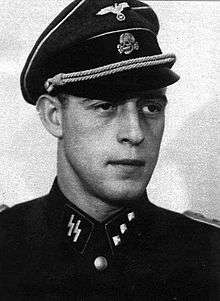Otto Günsche
| Otto Günsche | |
|---|---|
 Günsche as a SS-Untersturmführer | |
| Born |
24 September 1917 Jena, Saxe-Weimar-Eisenach, German Empire |
| Died |
2 October 2003 (aged 86) Lohmar, North Rhine-Westphalia, Germany |
| Allegiance |
|
| Service/branch |
|
| Years of service | 1933–45 |
| Rank | Sturmbannführer |
| Unit |
|
| Battles/wars | World War II |
Otto Günsche (24 September 1917 – 2 October 2003) was a Sturmbannführer in the Waffen-SS and a member of 1st SS Division Leibstandarte SS Adolf Hitler (LSSAH) before he became Adolf Hitler's personal adjutant. He was captured by soldiers of the Red Army on 2 May 1945. After various prisons and labour camps in the USSR, he was released from Bautzen Penitentiary on 2 May 1956.[1]
Biography
Günsche was born in Jena in Thuringia. After leaving secondary school at 16 he volunteered for the Leibstandarte SS Adolf Hitler and joined the Nazi Party on 1 July 1934.[1] He first met Adolf Hitler in 1936. He was Hitler's SS adjutant from 1940 to 1941. From 1 January 1941 to 30 April 1942, he attended the SS officer's academy.[1] He then had front-line combat service as a Panzer Grenadier company commander with the LSSAH. On 12 January 1943, Günsche became a personal adjutant for Hitler.[1] From August 1943 to 5 February 1944, Günsche fought on the Eastern Front and in France.[1] In March 1944 he was again appointed a personal adjutant for Hitler.[2] As a personal SS adjutant (Persönliche Adjutanten) to Hitler, Günsche was also a member of the Führerbegleitkommando which provided security protection for Hitler.[3] During the war, one or two were always present with Hitler during the military situation conferences.[4] He was present at the 20 July 1944 attempt to kill Hitler at the Wolf's Lair in Rastenburg. The bomb explosion burst Günsche's eardrums and caused him to receive a number of contusions.[5]
As the end of the Third Reich became imminent, Günsche was tasked by Hitler with ensuring the cremation of his body after his death on 30 April 1945.[6] He stood guard outside the room as Hitler and Eva Braun committed suicide.[7] Later, having ensured that the bodies were burnt using gasoline supplied by Hitler's chauffeur Erich Kempka, Günsche left the Führerbunker after midnight on 1 May.[8] He was captured by Soviet troops encircling the city on 2 May 1945 and flown to Moscow for interrogation by the NKVD.[1]
He was imprisoned in Moscow and Bautzen in East Germany and released on 2 May 1956.[1] During imprisonment, Günsche and Heinz Linge were primary sources for Operation Myth, the biography of Hitler which was prepared for Joseph Stalin. The dossier was edited by Soviet NKVD (later superseded by the MVD, separate from the agency of the KGB, formed in 1954) officers. The report was received by Stalin on 30 December 1949. The report was published in book form in 2005 under the title: The Hitler Book: The Secret Dossier Prepared for Stalin from the Interrogations of Hitler's Personal Aides.
Günsche died of heart failure at his home in Lohmar, North Rhine-Westphalia in 2003. He had three children.[9]
Awards and decorations
- Wound Badge in Silver
- Infantry Assault Badge
- Iron Cross 2nd Class
- Iron Cross 1st Class
- War Merit Cross - 2nd Class with Swords
Portrayal in the media
- In the 2004 German film Downfall (Der Untergang), Otto Günsche is portrayed by Götz Otto.
- In the 1981 TV film The Bunker he is played by British actor Andrew Ray.
References
Citations
- 1 2 3 4 5 6 7 Joachimsthaler 1999, p. 281.
- ↑ Hamilton 1984, p. 149.
- ↑ Hoffmann 2000, pp. 54–56.
- ↑ Hoffmann 2000, p. 55.
- ↑ Hamilton 1984, p. 148.
- ↑ Kershaw 2008, p. 954.
- ↑ Kershaw 2008, p. 955.
- ↑ Kershaw 2008, pp. 954, 956, 957, 960.
- ↑ Associated Press 2003.
Bibliography
- Eberle, Henrik; Uhl, Matthias, eds. (2005). The Hitler Book: The Secret Dossier Prepared for Stalin from the Interrogations of Hitler's Personal Aides. New York: Public Affairs. ISBN 978-1-58648-366-1.
- Hamilton, Charles (1984). Leaders & Personalities of the Third Reich, Vol. 1. R. James Bender Publishing. ISBN 0-912138-27-0.
- Hoffmann, Peter (2000) [1979]. Hitler's Personal Security: Protecting the Führer 1921-1945. New York: Da Capo Press. ISBN 978-0-30680-947-7.
- Joachimsthaler, Anton (1999) [1995]. The Last Days of Hitler: The Legends, the Evidence, the Truth. Trans. Helmut Bögler. London: Brockhampton Press. ISBN 978-1-86019-902-8.
- Kershaw, Ian (2008). Hitler: A Biography. New York: W. W. Norton & Company. ISBN 0-393-06757-2.
- O'Donnell, James (2001) [1978]. The Bunker. New York: Da Capo Press. ISBN 0-306-80958-3.
- Associated Press (October 14, 2003). "Otto Günsche, 86, Who Helped to Burn Hitler's Body, Dies". The New York Times.
External links
- Otto Günsche in the German National Library catalogue
.svg.png)